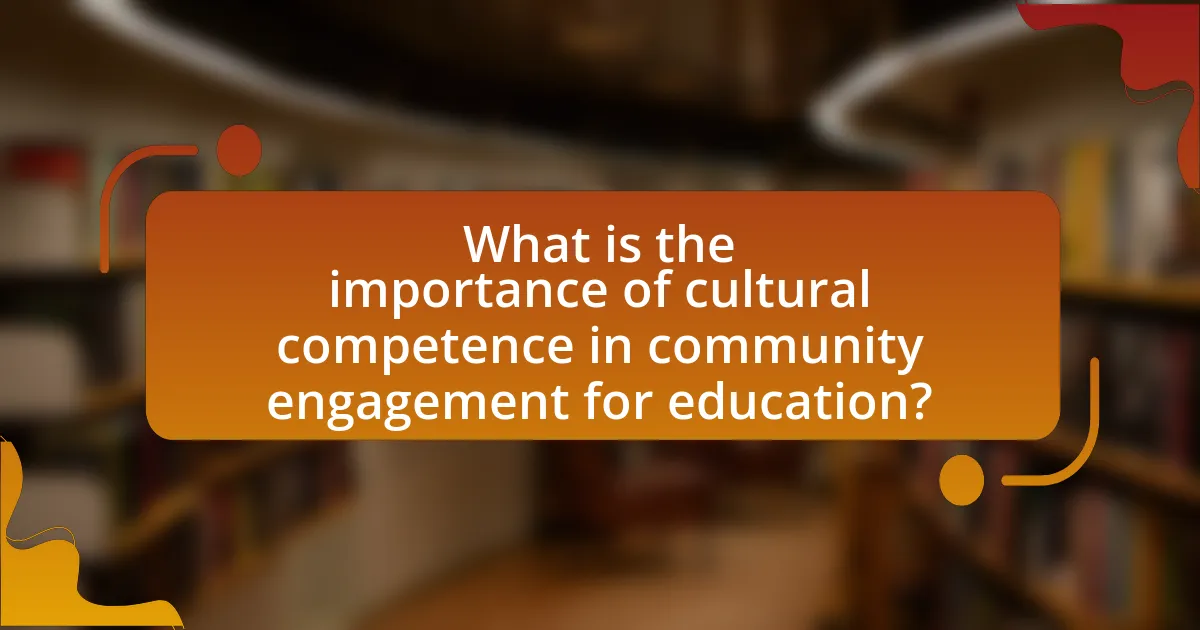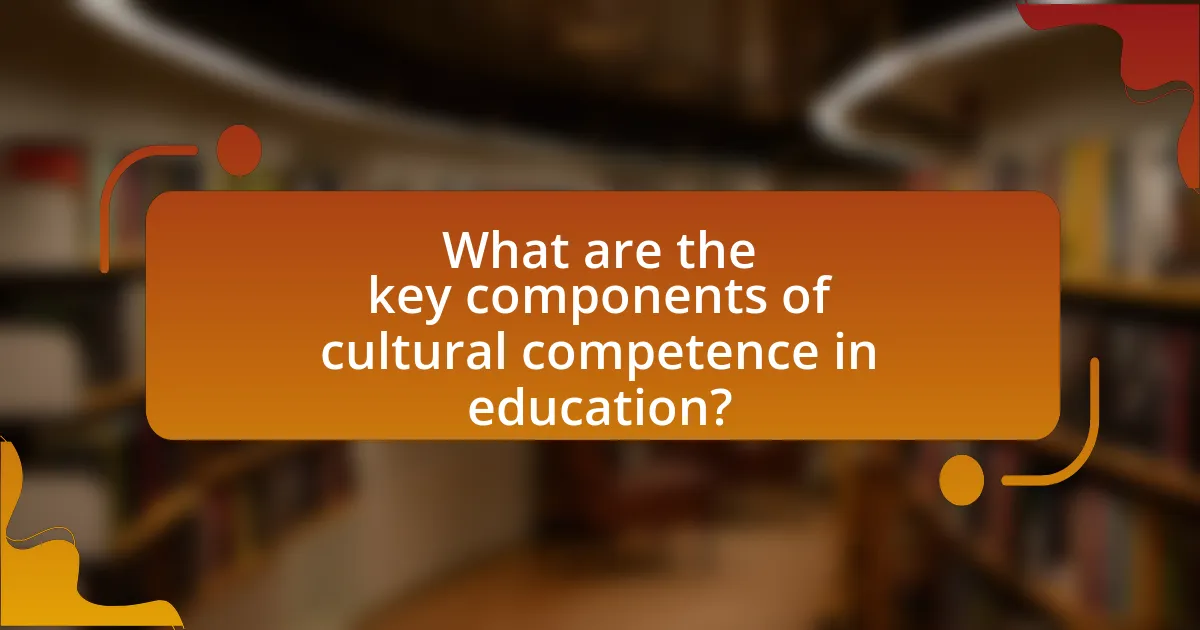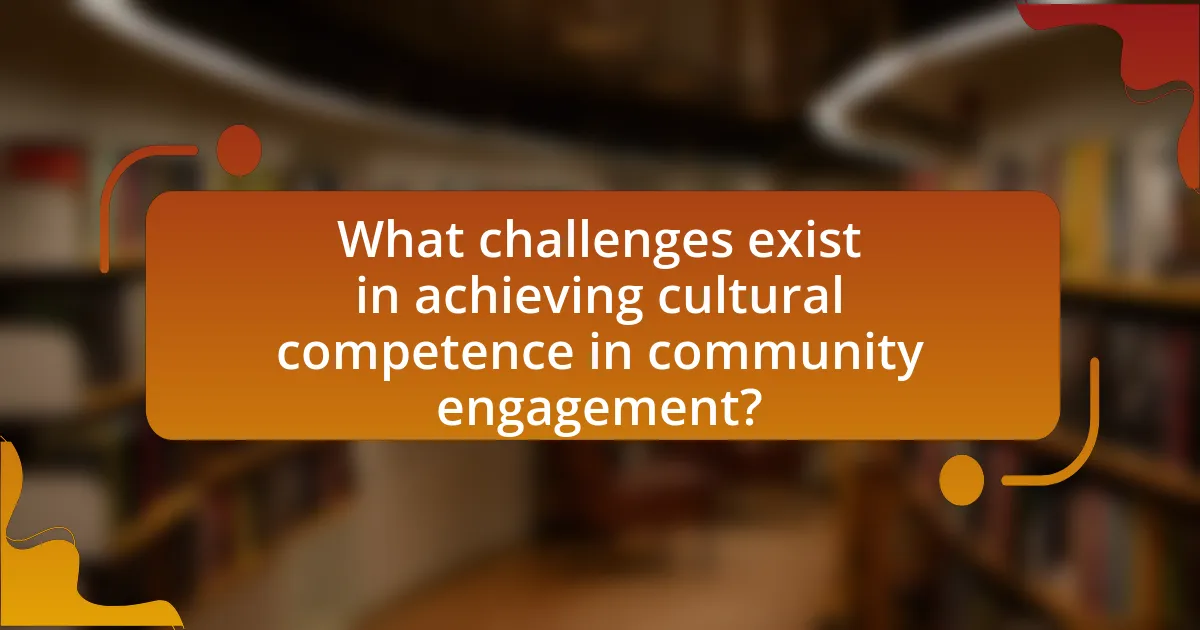Cultural competence is a vital aspect of community engagement in education, as it enhances communication and collaboration among diverse groups. This article explores the significance of cultural competence in educational settings, highlighting its impact on student learning outcomes, inclusivity, and community involvement. Key components include awareness of cultural identities, effective communication, and the adaptation of teaching methods to meet diverse needs. The article also addresses challenges in achieving cultural competence, such as systemic inequalities and misconceptions, while offering strategies for improvement, including professional development and community collaboration.

What is the importance of cultural competence in community engagement for education?
Cultural competence is crucial in community engagement for education as it fosters effective communication and collaboration among diverse groups. By understanding and respecting cultural differences, educators can build trust and rapport with students and families, leading to increased participation and support in educational initiatives. Research indicates that culturally competent practices enhance student achievement and engagement, as they create inclusive environments that reflect the diverse backgrounds of the community. For instance, a study by the National Education Association found that culturally responsive teaching significantly improves student outcomes, particularly for marginalized groups. This evidence underscores the necessity of cultural competence in bridging gaps between educational institutions and the communities they serve.
Why is cultural competence essential in educational settings?
Cultural competence is essential in educational settings because it enhances the ability of educators to effectively teach and engage students from diverse backgrounds. This competence fosters an inclusive environment that respects and values cultural differences, which is crucial for student success. Research indicates that culturally competent teaching practices lead to improved academic outcomes, as they help to bridge the gap between students’ cultural experiences and the curriculum. For instance, a study by Gay (2010) in “Culturally Responsive Teaching: Theory, Research, and Practice” demonstrates that culturally responsive pedagogy significantly boosts student engagement and achievement, particularly among minority students. Thus, cultural competence not only supports individual learning but also promotes equity within the educational system.
How does cultural competence influence student learning outcomes?
Cultural competence significantly enhances student learning outcomes by fostering an inclusive and supportive educational environment. When educators possess cultural competence, they can effectively engage with diverse student populations, tailoring their teaching methods to meet varied cultural needs. Research indicates that culturally responsive teaching practices lead to improved academic performance, higher student engagement, and increased retention rates. For instance, a study by Gay (2010) in “Culturally Responsive Teaching: Theory, Research, and Practice” demonstrates that students from diverse backgrounds perform better academically when their cultural identities are acknowledged and integrated into the curriculum. This alignment between teaching practices and student backgrounds not only boosts learning outcomes but also promotes a sense of belonging among students.
What role does cultural competence play in fostering inclusive environments?
Cultural competence plays a crucial role in fostering inclusive environments by enabling individuals and organizations to understand, communicate with, and effectively interact with people across diverse cultures. This understanding promotes respect and appreciation for different backgrounds, which is essential for creating a welcoming atmosphere. Research indicates that culturally competent practices lead to improved educational outcomes, as they help reduce biases and stereotypes, thereby enhancing collaboration among diverse groups. For instance, a study published in the “Journal of Educational Psychology” found that culturally responsive teaching methods significantly improved student engagement and achievement in multicultural classrooms.
How does cultural competence enhance community engagement?
Cultural competence enhances community engagement by fostering trust and understanding between diverse groups. When individuals and organizations demonstrate awareness and respect for different cultural backgrounds, they create an inclusive environment that encourages participation. Research indicates that culturally competent practices lead to higher levels of community involvement, as seen in a study by the National Education Association, which found that schools with culturally responsive programs reported increased parental engagement and student achievement. This connection between cultural competence and community engagement is crucial for effective educational initiatives, as it allows for tailored approaches that resonate with the unique needs of various communities.
What strategies can be employed to improve cultural competence in community engagement?
To improve cultural competence in community engagement, organizations can implement strategies such as training programs, community partnerships, and inclusive communication practices. Training programs focused on cultural awareness and sensitivity can enhance understanding of diverse backgrounds, as evidenced by studies showing that such training increases empathy and reduces biases among participants. Establishing partnerships with local cultural organizations fosters trust and collaboration, allowing for more effective engagement with diverse communities. Additionally, employing inclusive communication practices, such as using culturally relevant materials and languages, ensures that all community members feel valued and understood, which is supported by research indicating that inclusive communication leads to higher participation rates in community initiatives.
How can cultural competence bridge gaps between educators and diverse communities?
Cultural competence can bridge gaps between educators and diverse communities by fostering mutual understanding and respect. When educators develop cultural competence, they gain the ability to recognize and appreciate the diverse backgrounds, values, and experiences of their students and their families. This understanding leads to more effective communication and collaboration, which are essential for creating inclusive educational environments. Research indicates that culturally competent educators can improve student engagement and academic performance, as they are better equipped to address the unique needs of students from various cultural backgrounds. For example, a study published in the “Journal of Teacher Education” found that teachers who received training in cultural competence reported increased confidence in their ability to connect with students from diverse communities, ultimately enhancing the educational experience for all involved.

What are the key components of cultural competence in education?
The key components of cultural competence in education include awareness of one’s own cultural identity, understanding the cultural backgrounds of students, effective communication across cultures, and the ability to adapt teaching methods to meet diverse cultural needs. Awareness of one’s own cultural identity allows educators to recognize their biases and assumptions, which is essential for fostering an inclusive environment. Understanding the cultural backgrounds of students helps educators to connect with them and create relevant learning experiences. Effective communication across cultures involves recognizing and respecting different communication styles, which enhances student engagement. Finally, adapting teaching methods to meet diverse cultural needs ensures that all students have equitable access to education, promoting academic success and social-emotional well-being.
What skills are necessary for developing cultural competence?
Developing cultural competence requires skills such as active listening, empathy, and adaptability. Active listening enables individuals to understand diverse perspectives and experiences, fostering effective communication. Empathy allows for the recognition and appreciation of cultural differences, which is essential in building trust and rapport within diverse communities. Adaptability is crucial for responding appropriately to varying cultural contexts and practices. Research indicates that these skills enhance collaboration and engagement in educational settings, ultimately leading to more inclusive and effective community interactions.
How do self-awareness and reflection contribute to cultural competence?
Self-awareness and reflection significantly enhance cultural competence by enabling individuals to recognize their own biases and cultural influences. This recognition allows for a deeper understanding of diverse perspectives and experiences, which is essential in educational settings that engage with varied communities. Research indicates that self-awareness fosters empathy, as individuals become more attuned to the feelings and viewpoints of others, thereby improving communication and collaboration. For instance, a study published in the Journal of Educational Psychology found that educators who practiced self-reflection were more effective in addressing the needs of culturally diverse students, leading to improved academic outcomes. Thus, self-awareness and reflection are critical components in developing the skills necessary for effective cultural competence.
What knowledge is essential for understanding diverse cultural backgrounds?
Understanding diverse cultural backgrounds requires knowledge of cultural norms, values, and practices specific to different groups. This knowledge includes awareness of historical contexts, social structures, and communication styles that shape cultural identities. For instance, recognizing that collectivist cultures prioritize group harmony over individualism can enhance interpersonal interactions and community engagement. Additionally, familiarity with the impact of colonial histories on contemporary cultural dynamics is crucial, as it informs power relations and social inequalities. Studies, such as those by Geert Hofstede on cultural dimensions, provide empirical evidence supporting the significance of these factors in fostering cultural competence.
How can educators assess their cultural competence?
Educators can assess their cultural competence through self-reflection, feedback from peers and students, and participation in professional development focused on cultural awareness. Self-reflection allows educators to evaluate their own biases and understanding of diverse cultures, while feedback provides insights into how their practices are perceived by others. Professional development programs, such as those offered by the National Association for Multicultural Education, equip educators with the necessary skills and knowledge to enhance their cultural competence. Research indicates that educators who engage in these assessments are more effective in fostering inclusive learning environments, as highlighted in studies by the American Educational Research Association, which emphasize the correlation between cultural competence and student engagement.
What tools and frameworks are available for evaluating cultural competence?
Tools and frameworks available for evaluating cultural competence include the Cultural Competence Assessment Tool (CCAT), the Intercultural Development Inventory (IDI), and the Cultural Competence Continuum. The CCAT provides a structured approach to assess an organization’s cultural competence through self-assessment and feedback mechanisms. The IDI measures an individual’s intercultural sensitivity and development, offering insights into their cultural competence level. The Cultural Competence Continuum outlines stages of cultural competence, helping organizations identify their current position and areas for improvement. These tools are validated through research and practical application in various educational and community engagement settings, demonstrating their effectiveness in evaluating cultural competence.
How can feedback from the community enhance cultural competence assessments?
Feedback from the community can enhance cultural competence assessments by providing real-world insights and perspectives that reflect the diverse experiences of community members. This input allows organizations to identify gaps in understanding and areas for improvement in cultural competence, ensuring that assessments are relevant and effective. For instance, studies have shown that community feedback can lead to more tailored educational programs that address specific cultural needs, thereby increasing engagement and effectiveness. By incorporating community voices, assessments become more comprehensive and aligned with the actual cultural dynamics present, ultimately fostering a more inclusive environment.

What challenges exist in achieving cultural competence in community engagement?
Achieving cultural competence in community engagement faces several challenges, including language barriers, differing cultural norms, and systemic inequalities. Language barriers hinder effective communication, making it difficult for community members to express their needs and for organizations to understand them. Differing cultural norms can lead to misunderstandings and misinterpretations of community values and practices, which may alienate individuals from engagement efforts. Systemic inequalities, such as socioeconomic disparities, can create distrust between communities and organizations, further complicating efforts to foster inclusive participation. These challenges necessitate targeted strategies to enhance understanding and collaboration among diverse community members.
What barriers do educators face in developing cultural competence?
Educators face several barriers in developing cultural competence, including lack of training, limited resources, and personal biases. The absence of structured professional development programs specifically focused on cultural competence hinders educators’ ability to effectively engage with diverse student populations. Research indicates that only 25% of teachers feel adequately prepared to address cultural diversity in their classrooms (National Center for Education Statistics, 2020). Additionally, educators often encounter insufficient access to culturally relevant materials and support systems, which further complicates their efforts. Personal biases and stereotypes can also impede educators’ willingness to embrace cultural differences, affecting their interactions with students and families from diverse backgrounds.
How can systemic issues impact cultural competence in education?
Systemic issues can significantly hinder cultural competence in education by perpetuating inequities and biases within educational systems. These issues, such as socioeconomic disparities, institutional racism, and inadequate funding, create environments where diverse cultural perspectives are undervalued or ignored. For instance, research by the National Center for Education Statistics indicates that schools in low-income areas often lack resources to support culturally relevant curricula, which diminishes students’ engagement and understanding of their own cultural backgrounds. Consequently, educators may struggle to develop the necessary skills to effectively teach and connect with students from diverse backgrounds, ultimately impacting students’ academic success and social integration.
What are common misconceptions about cultural competence?
Common misconceptions about cultural competence include the belief that it is solely about knowledge of different cultures, that it can be achieved through a single training session, and that it is only relevant for specific professions. Cultural competence encompasses not just knowledge but also skills and attitudes that promote effective interactions across diverse cultural contexts. Research indicates that ongoing education and practice are essential for developing true cultural competence, as highlighted in the study “Cultural Competence Education: A Review of the Literature” by Betancourt et al. (2003), which emphasizes the need for continuous learning and adaptation. Additionally, cultural competence is vital in various fields, including healthcare, education, and social services, underscoring its broad relevance beyond specific roles.
How can these challenges be overcome?
To overcome challenges in cultural competence within community engagement for education, organizations must implement targeted training programs for educators and community leaders. These programs should focus on understanding diverse cultural backgrounds, fostering empathy, and enhancing communication skills. Research indicates that culturally responsive teaching improves student engagement and academic performance, as evidenced by a study published in the “Journal of Educational Psychology,” which found that culturally relevant pedagogy significantly boosts student achievement among minority groups. Additionally, establishing partnerships with local cultural organizations can provide valuable resources and insights, facilitating a more inclusive educational environment.
What role does professional development play in enhancing cultural competence?
Professional development plays a crucial role in enhancing cultural competence by providing educators with the knowledge and skills necessary to understand and engage effectively with diverse cultural backgrounds. Through targeted training programs, educators learn about cultural awareness, sensitivity, and the impact of cultural differences on learning and communication. Research indicates that professional development initiatives that focus on cultural competence lead to improved educational outcomes for students from various backgrounds, as they foster an inclusive environment that respects and values diversity. For instance, a study published in the “Journal of Teacher Education” found that teachers who participated in cultural competence training reported increased confidence in addressing the needs of culturally diverse students, thereby enhancing their teaching effectiveness and student engagement.
How can collaboration with community leaders support cultural competence initiatives?
Collaboration with community leaders enhances cultural competence initiatives by leveraging their local knowledge and influence to foster trust and engagement within diverse populations. Community leaders possess insights into cultural norms, values, and challenges faced by their communities, which can inform the development of culturally relevant educational programs. For example, research by the American Psychological Association indicates that culturally competent practices improve educational outcomes by addressing the specific needs of students from various backgrounds. By partnering with these leaders, educational institutions can create tailored strategies that resonate with community members, ultimately leading to more effective and inclusive educational environments.
What best practices can be implemented for effective cultural competence in education?
Effective cultural competence in education can be achieved through practices such as incorporating diverse curricula, fostering inclusive environments, and providing ongoing professional development for educators. Diverse curricula that reflect various cultures and perspectives enhance students’ understanding and appreciation of different backgrounds, which is supported by research indicating that culturally relevant teaching improves student engagement and achievement. Creating inclusive environments involves actively promoting respect and understanding among students from different cultural backgrounds, which has been shown to reduce bias and improve social cohesion in classrooms. Additionally, ongoing professional development equips educators with the skills and knowledge necessary to address cultural differences effectively, as evidenced by studies demonstrating that trained educators are more adept at implementing culturally responsive teaching strategies.
How can schools create culturally responsive curricula?
Schools can create culturally responsive curricula by integrating diverse cultural perspectives into the educational content and teaching methods. This involves incorporating materials that reflect the histories, values, and experiences of various cultural groups, ensuring that all students see themselves represented in their learning. Research indicates that culturally responsive teaching improves student engagement and academic performance, particularly among minority students. For instance, a study by Gay (2010) highlights that when curricula are aligned with students’ cultural backgrounds, it fosters a more inclusive learning environment, enhancing both understanding and respect among peers.
What are effective methods for engaging families from diverse backgrounds?
Effective methods for engaging families from diverse backgrounds include utilizing culturally relevant communication, fostering inclusive environments, and providing multilingual resources. Culturally relevant communication ensures that messages resonate with families’ values and traditions, which can enhance trust and participation. Creating inclusive environments, such as hosting community events that celebrate various cultures, encourages families to feel welcomed and valued. Additionally, providing multilingual resources, including translated materials and interpreters, facilitates better understanding and involvement. Research indicates that schools employing these strategies see increased family engagement and improved student outcomes, as highlighted in the study “Family Engagement in Diverse Communities” by the Harvard Family Research Project.
What practical steps can educators take to improve cultural competence?
Educators can improve cultural competence by actively engaging in professional development focused on diversity and inclusion. This includes attending workshops that address cultural awareness, understanding implicit biases, and learning effective communication strategies with diverse populations. Research indicates that educators who participate in such training are better equipped to create inclusive learning environments, as highlighted in a study by the National Education Association, which found that culturally competent educators positively impact student engagement and achievement. Additionally, educators should incorporate diverse perspectives into the curriculum, ensuring that materials reflect a variety of cultures and experiences, which fosters a more inclusive classroom atmosphere.


